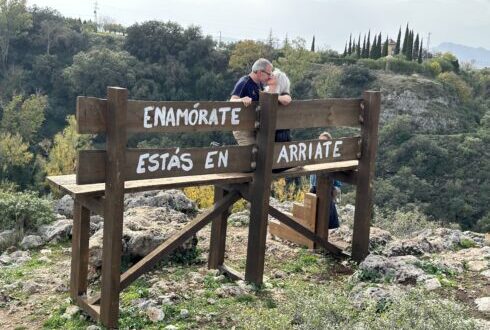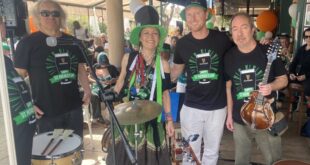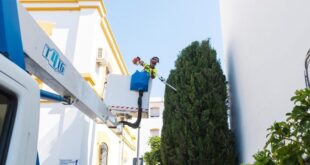The stunning white village of Arriate is home to no less than six songs dedicated to their patron saint St. Valentine.
Auroreros is a group of legendary singers who are well known to many locals. They go around the streets in the middle the night and serenade people.
Take a stroll through the village at daytime, and you’ll find a few other references to the fated lovemaker god.
There is a large Cupid’s arrow and a circular bench for lovers. The giant arrow also doubles as a great viewing point over the village, as well as up into the Serrania de Ronda Mountains.

Olive Press
Even the route is carefully designed to follow the nesting stork Valentina who has been in the high chimney stack at the edge of town for as long as anyone could remember.

Olive Press
All this happened because four centuries ago on Valentine’s Day Arriate was finally freed from Ronda, her big sister.
Indeed, it was on February 14, 1661, that the villagers clubbed together to pay 352,739 Maravedies – the currency back then – in order to buy their independence.
It was an auspicious occasion, as it signified that the village had finally reached adulthood and could now take control of its own destiny.
It has been a public holiday since St Valentine became its patron saint. This is one of only two Spanish towns, the other being in Aragon.

The Olive Press
And the town hall has gone one step further, rebranding Arriate as Andalucia’s official ‘Pueblo de Amor’ and encouraging star-crossed lovers from around the world to take a visit.
In addition to promoting the romantic backdrop of the mountains in the Serrania de Ronda region, the city also promotes its original architecture and charming local cuisine.
Francisco Javier Anet leads the charge to promote romance.
After studying Geography at University, he is an avid environmentalist and is pushing for the village to have amazing green spaces that extend into the Sierra de las Nieves National Park.
The Arroyo de la Ventilla is an amazing valley hidden in the mountains.
The little-known gorge – a mini version of Ronda’s Tajo and far less visited – is crammed full of flora and fauna, including orchids, eagles and even wild animals including genets and stoats.

Photo: CarGest
Cave houses and other ancient evidence of human existence dating back before the Romans are also fascinating.
Anet says, “It’s an amazing space that offers a true adventure to anyone seeking a genuine getaway.” We want to promote this natural way to life to anyone who is thinking about visiting the area.
Watch out for
Visit one of the three ham factories, some of which are centuries old. The number carved on the door of one of the shops in the pedestrianised Calle Callejuela proves that it has been operating as a shop for over a century.
Melgar is a family-run company that has shops in Ronda, Malaga and other nearby towns. They serve their own cheese and ham.
CINEMA PARADISO
Los Caireles, a restaurant and bar in the back of the 1940s Cine Ideal is a beautifully converted building. It closed in 1988, due to declining audiences, and became a Flamenco venue before being converted into a bar and a restaurant. Many of the original items, including advertising and film cameras are still present.
MULLETS ARE MARVELLOUS
El Muelle is a charming restaurant run by Dutchman Frank Rottgering on the edge town. It’s romantic to the extreme. The charm of this converted 100-year old railway building will be evident in the winter with a roaring fireplace and candles, and in the summer on the terrace at sunset.
 Costa News Spain Breaking News | English News in Spain.
Costa News Spain Breaking News | English News in Spain.





